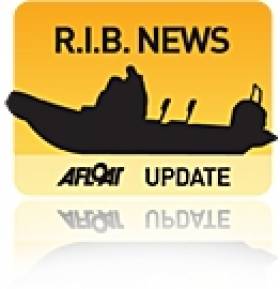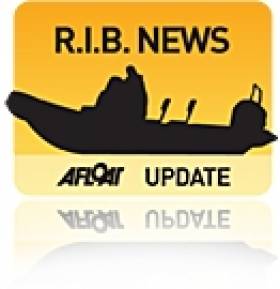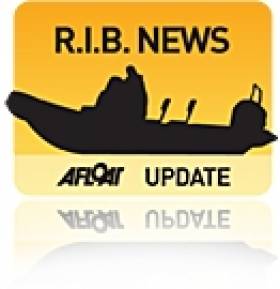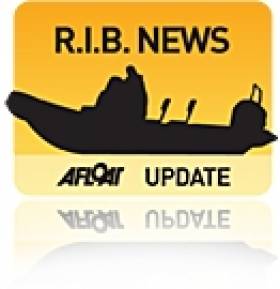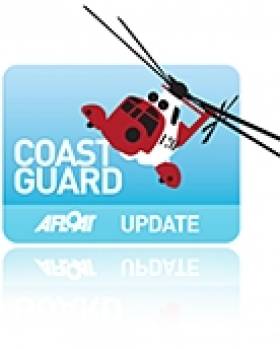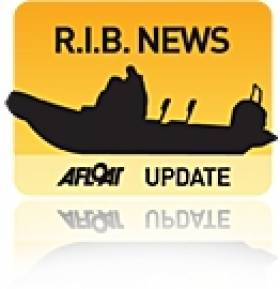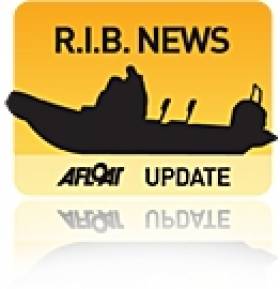Displaying items by tag: Rib
High-Speed Turn Led To Cornwall RIB Tragedy Says Official Report
#KillCord - An "exceptionally unusual" tight turn at high speed led to the death of a father and daughter and the serious injury of other family members in a tragic speedboat accident off Cornwall last year.
The Guardian reports on the conclusions of the official investigation into the incident on 5 May in which BSkyB executive Nick Milligan and his eight-year-old daughter Emily were struck and killed by the family's runaway RIB after being thrown overboard in the waters between Rock and Padstow.
It was previously found that the driver of the speedboat was not attached to the 'kill cord' that would have automatically shut off the engine. Instead, the boat continued to circle with its engine running, striking the family as they floated in the water.
Milligan's wife Victoria and four-year-old son Kit both sustained what were described by police as "life-changing injuries".
It has since emerged via the findings of the Maritime Accident Investigation Branch (MAIB) report that Victoria had been driving the boat in a slow wide turn when her husband reached across her to steer the boat hard to starboard at full speed.
The report added that "the manner in which Mr Milligan took the helm appears to have been out of character as he was known to be a safety conscious and prudent individual."
However, it was also found that the Milligans did not have a "good understanding" of how the speedboat would handle high-speed turns, nor were they aware of the hazards of their children being at the unstable front of the RIB.
The Guardian has much more on the story HERE.
New Location Means More Business For Sligo RIB Specialists
#TradeNews - Afloat.ie first reported in March last year on Inland Inflatables Services' planned relocation to larger premises in Collooney, Co Sligo.
And now the move is finally going ahead, as the RIB service business - one of the largest in Ireland - gets ready to set up in an impressive 8,000 square foot space as it celebrates its 10th anniversary in 2014.
As company head Ronan Keys told the Sunday Business Post recently: "Some people thought I was a bit crazy to make the move out of Sligo town to Collooney as such a time in the economy."
But as Keys adds, the numbers made sense, as the fall in property prices made purchasing the larger out-of-town space a much better deal, and in turn will allow the company to take on more business - and more staff.
RIB Victory for Mazda UK in Round Ireland Challenge
#RIB – Mazda UK and partner Linley Swan GP have scored a class victory in the arduous Powerboat and RIB Round Ireland Challenge 2013. Winning skipper, Tom Montgomery-Swan led the 13 remaining boats into Kilmore Quay at 2pm on August 4th, concluding ten days at sea through huge seas and high winds.
Tom Montgomery-Swan, 24 from Exeter, Devon, has been racing boats almost all of his life and said; "The Powerboat and RIB Round Ireland Challenge was one of the toughest ocean challenges in this part of the world, so to finish, let alone lead the fleet with Mazda was a truly incredible experience. With our newly Linley Swan designed boat, and capable Mazda CX-5 support car, we proved Mazda's SKYACTIV principals worked on water, and on land."
To contest the Round Ireland Challenge, Linley Swan produced a brand new boat using a proven Ribeye A Series hull design. The starting point for the project was Mazda SKYACTIV philosophy of lightweight, environmentally sound design without compromise on performance or handling.
Designed to defy convention, the boat introduced new technologies, and a new way of thinking about design for Linley Swan.
The six metre vessel features race specification materials, advanced electronics packages, fuel efficient engine technology, and custom suspension - a shock mitigating console and seat designed by a NASCAR firm in Canada.
Mazda UK supported Linley Swan with the popular CX-5 sports utility vehicle (SUV), which saw action as the exclusive land vehicle for the Linley Swan GP race team. The car covered almost 2,500 miles, delivering food, supplies, mechanical parts and much more to the boat throughout the event.
The Mazda CX-5 proved to be the ideal event support vehicle for Linley Swan. As well as being a welcome sight dockside at the end of each leg, the car's practical, capable nature ensured it offered indispensable support, whilst maintaining an average fuel consumption of over 45mpg and a reliable service.
Offering good towing capabilities, ample space for kit, and frugal fuel consumption, the Mazda CX-5 is an environmentally friendly SUV with excellent driving credentials to deliver the support crew to each rendezvous dry and in comfort.
"Mazda proved to be the ideal partner for this event," commented Linley Swan GP Skipper Tom Montgomery-Swan. "We needed a stylish, economical car capable of towing our RIB whilst delivering on comfort for the crew and practicality for lugging the expanse of kit - all assets we need to address the logistical challenge of moving the RIB safely and at a greatly reduced cost to more traditional towing vehicles.
Montgomery-Swan concludes: "We wanted a vehicle partner which delivered on our brand values of performance and reliability whilst being environmentally friendly, and Mazda has proved its commitment to the environment with its SKYACTIV technology which enables them to produce cars with reduced CO2 emissions whilst using less fuel. This fitted well with our environmental values to preserve the marine landscape by using biodegradable oil and fuel in the boat."
Delayed Round Ireland RIB Challenge Heads for Royal Cork
#ribchallenge – 10000hrs Sunday – Afloat.ie just received news from ribber Derek Shaw on Nyzod, a Zodia Pro Open 650, on the RIB Challenge that the fleet is en route to Royal Cork Yacht Club and has just passed the Mizen and estimate possible arrival somewhere between 1pm and 3pm.
Nyzod is the only Irish entry in the challenge and has on board John Garvey an RNLI Cox, Walker Shaw, Richie Cunningham, Donal O'Connor and Paul Lydon.
The Challenge started out with twenty five RIBS and one motor cruiser ranging in size from 4.7m up to 11.5m, a week ago. The fleet met bad weather coming down the west coast and have been stormbound in Dingle, Co. Kerry for the past two days.
RIBs ran into difficulty last Thursday in County Kerry prompting Fenit lifeboat to issue a reminder about how important it is to get an up to date forecast and plan your journey carefully and stay in regular contact with the Coastguard. Fenit ALB launched to assist three ribs which got into difficulty in Brandon bay. Fenit lifeboat took one vessel in tow, and escorted the other two ribs to Fenit harbour.
Organiser of the event Hugo Montgomery-Swan, gave a most graphic description of the conditions encountered by some of the boats approaching Brandon Bay. Seas of ferocious ferocity were encountered with winds whipping and twisting enormous sheets of white water some 300 to 400 feet long and with twisters clearly seen.
The Irish Coastguard were advising and Fenit life boat was tasked and took a RIB that had lost power and was being towed by a fellow challenger, under tow back to Fenit marina. Three boats spent the night there and the second three boats of this party were advised by the Coastguard to make for the safety of a beach inside Brandon where they spent the night on the beach, according to local reports.
Round Ireland RIB Challenge Skipper Thrown From Boat, Rescued by Coastguard Helicopter
#RIB – An air sea rescue for a solo Rigid Hulled Inflatable Boat (RIB) skipper in the Irish Sea got the 2013 Round Ireland RIB Challenge off to a dramatic start at the weekend.
The 24–boat circumnavigation RIB fleet arrived in Dun Laoghaire marina on schedule yesterday afternoon, but one of their number was lucky to be alive after a Search and Rescue operation on Friday plucked a solo skipper from the sea, some nine miles offshore from Milford Haven.
The RIB driver was thrown out of his craft, and a signal from his personal locator beacon was picked up. The incident happened during a crossing from Milford Haven in Wales to the start of the RIB Challenge at Kilmore Quay in County Wexford on Friday afternoon, according to HM Coastguard.
The RIB named Merlin is a Gemini Waverider 4.95m RIB, according to details on the Round Ireland Challenge website.
As Afloat.ie reported on Friday, Falmouth Coastguard contacted Milford Haven Coastguard about a signal from a PLB, (personal locator beacon) located nine miles offshore from St David's Head on Friday afternoon. Coastguard officers checked vessel and contact details on the UK Beacon Registry database and identified that this PLB was registered to Merlin.
Milford Haven Coastguard requested the launch of St Davids RNLI Lifeboat and the rescue helicopter from RAF Chivenor.
The rescue helicopter located the man in the water using the signal from the beacon and winched him into the aircraft. The man was checked by the crew in the helicopter and in agreement with Milford Haven Coastguard returned to his vessel and has made the return voyage to Milford Haven.
He was thrown into the water but was wearing a survival suit, lifejacket and had a PLB with him. The man spent approximately three hours in the water.
Milford Haven Coastguard Watch Manager Rob James says:
"Fortunately this skipper was prepared for a single handed voyage offshore and having the right gear has saved his life. The kill cord on the vessel did work and cut the engine when he was thrown from the boat.
Wearing a survival suit and lifejacket enabled him to survive the three hours in the sea while awaiting rescue and the PLB which was activated sent the exact location of the casualty to the Coastguard."
A tweet from the Challenge organisers on Saturday said Merlin had been 'delayed' and would join the fleet in Dun Laoghaire marina. The fleet, drawn largely from the UK but with Irish, German and Luxembourg entries too, enjoyed an evening at Dun Laoghaire last night and headed north for Bangor marina on Belfast Lough at 9am this morning.
#coastguard – A man has been rescued nine miles off shore after he was thrown from his vessel and a signal from his personal locator beacon was picked up.
At 4.07pm last night Falmouth Coastguard contacted Milford Haven Coastguard about a signal from a PLB, (personal locator beacon) located nine miles offshore from St David's Head. Coastguard officers checked vessel and contact details on the UK Beacon Registry database and identified that this PLB was registered to the RIB (Rigid Hulled Inflatable Boat) Merlin.
Milford Haven Coastguard requested the launch of St Davids RNLI Lifeboat and the rescue helicopter from RAF Chivenor. The rescue helicopter located the man in the water using the signal from the beacon and winched him into the aircraft. The man was checked by the crew in the helicopter and in agreement with Milford Haven Coastguard returned to his vessel and has made the return voyage to Milford Haven.
The single handed skipper was on voyage from Milford Haven to Kilmore Quay in Ireland when a wave knocked him out of his RIB. He was thrown into the water but was wearing a survival suit, lifejacket and had a PLB with him. The man spent approximately three hours in the water.
Milford Haven Coastguard Watch Manager Rob James says:
"Fortunately this skipper was prepared for a single handed voyage offshore and having the right gear has saved his life. The kill cord on the vessel did work and cut the engine when he was thrown from the boat.
Wearing a survival suit and lifejacket enabled him to survive the three hours in the sea while awaiting rescue and the PLB which was activated sent the exact location of the casualty to the Coastguard."
Welsh Rib Run Makes Best of Dublin Bay Heat Wave
A Donegal based Redbay 6.1m RIB, Deep Six (the 'welcome wagon') along with another RIB from Belfast ran out to the Kish lighthouse on Dublin Bay on Saturday to escort a 10–boat RIB fleet from Wales up the river Liffey and into the heart of Dublin city.
The RIBs had departed the Welsh coast on Saturday morning and the fleet was on its second annual RIBnet Caernarfon to Dun Laoghaire cruise. 33 ribbers were involved.
After arriving on Dublin Bay the crews proceeded to the city centre for a spectacular run up the river on one of the best days of the summer so far.
Navigation up the Liffey was easily handled even though the Ribbers encountered a new bridge that gave an air draft clearance of roughly 2.2 metres for boats/a-frames.
According to reports, the crews had a ball and were 'impressed' with local hospitality at Dun Laoghaire marina and the nearby Purty Kitchen pub.
A third run to Dublin is planned again next year.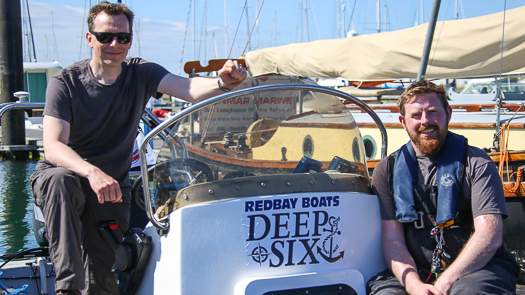
Donegal ribbers Richard (left) and Danny provided a welcome for ten Welsh RIbs in Dublin at the weekend. Photo: Afloat.ie
#KillCord - An official report into the tragic speedboat accident in Cornwall earlier this month that killed a father and daughter says that the driver was not attached to the boat's 'kill cord'.
As previously reported on Afloat.ie, BSkyB executive Nick Milligan and his eight-year-old daughter Emily were struck by the family's runaway RIB after being thrown overboard from the vessel on the afternoon of Sunday 5 May.
Four other family members were struck by the runaway boat as it circled in the water off Padstow. Nick's wife Victoria and four-year-old son Kit are recovering after sustaining "life-changing" leg injuries.
Police were reportedly investigating the role played in the incident by the boat's kill cord or safety lanyard, a device attached to the throttle that should automatically cut engine power if the driver is thrown from the vessel.
Now The Guardian reports the Marine Accident Investigation Branch's (MAIB) conclusion that the 8m Cobra RIB was fitted with a kill cord, but it was not attached to the driver.
It has not yet been determined who was driving the speedboat at the time of the accident, nor is it clear how the family was thrown from the vessel.
The report added: "The kill cord serves only one purpose, to stop the engine when the driver moves away from the controls.
"To ensure that this tragic accident is not repeated it is essential that all owners and operators of vessels ensure they are fitted with kill cords."
Irish Rigid Inflatable Boat (RIB) builder Red Bay Boats is exhibiting one of its giant 16–metre Pilot Boat Stormforce RIBs at next month's Seaworks commercial exhibition in Southampton.
Intended for a variety of commercial applications including Pilot, Patrol, and passenger carrying usages this new Stormforce 1650 is a development of the County Antrim firm's Rigid Inflatable Boats. Of particular interest is the keen handling of the 'keel–less' demonstrator craft 'Caledonia' (pictured above and vid below) when manoeuvring alongside ships during recent trials.
The Cushendall firm headed by Tom McLaughlin has been busy working on the commercial side of the RIB business and is seeking Port customers for The 1650 which has a deep-V hull, with foam filled collars bonded to the hull sides.
Red Bay is also exhibiting a new 12 metre jet powered RIB, a 7.4m with a new Hyundai diesel and two more outboard driven 7.4s with Suzuki engines.
Police Focus On Kill Cord In Cornwall RIB Tragedy
#KillCord - Police in Cornwall investigating the deaths of a father and daughter in a speedboat accident off Padstow at the weekend are focusing on the boat's 'kill cord', according to BBC News.
BSkyB executive Nick Milligan and his eight-year-old daughter were struck by the family's runaway Cobra RIB after losing control of the vessel and being thrown overboard.
Four other family members in the water struck by the 8m-long boat were hospitalised, with the BBC reporting that Milligan's wife Victoria and four-year-old son Kit suffered "serious, potentially life-changing injuries".
Witnesses describe the speedboat circling to hit the family after turning sharply and throwing them into the water, then continuing to run around in circles before it was stopped by local waterskiing instructor Charlie Toogood who jumped on board.
Investigators are looking closely at the kill cord or safety lanyard, a device attached to a boat's throttle that should automatically cut engine power if the boat's pilot goes overboard.
A malfunctioning kill cord was identified in an incident in Cork Harbour last summer in which a RIB pilot lost an arm after he was thrown overboard and subsequently struck by his runaway vessel, as previously reported on Afloat.ie.
Months before, an angler died and another was treated for hypothermia after being thrown overboard and separated from their vessel, a result of neither man using the kill cord on their boat's engine.


























